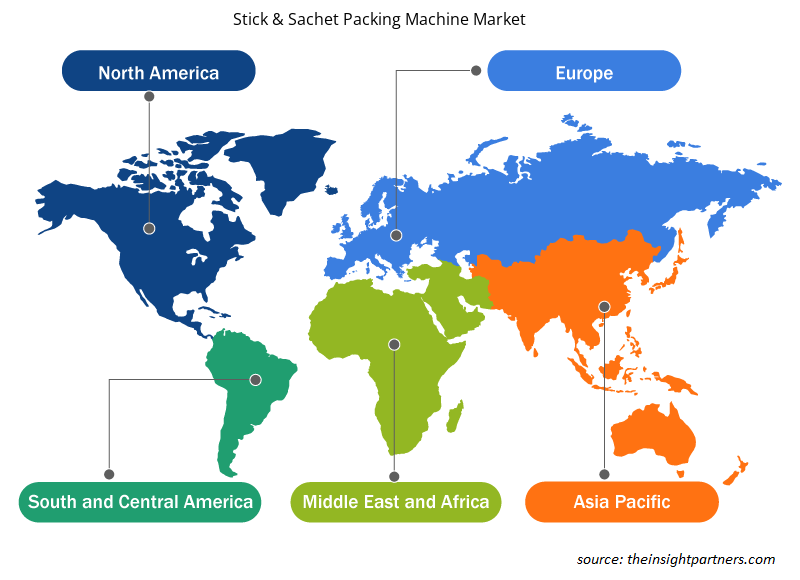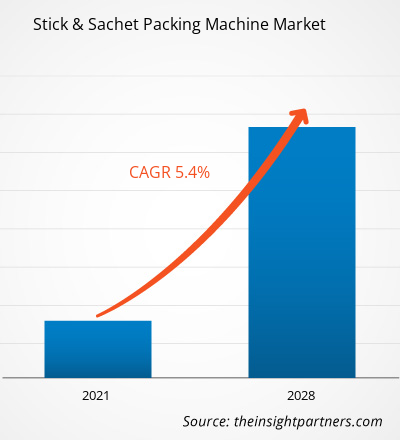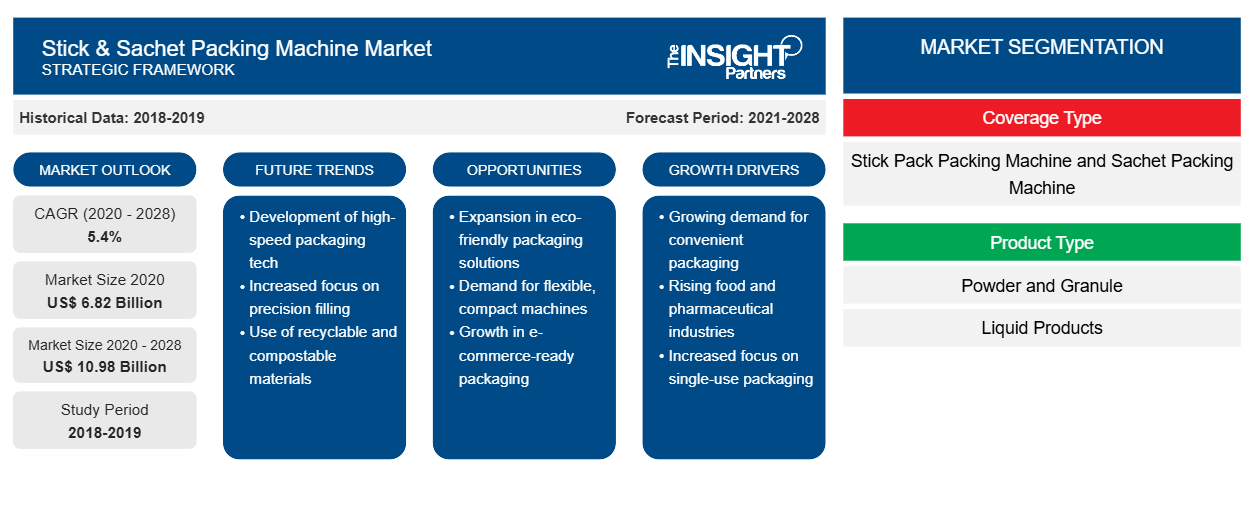El mercado de máquinas envasadoras en barra y en bolsitas se valoró en 6.819,38 millones de dólares estadounidenses en 2020 y se espera que alcance los 10.978,92 millones de dólares estadounidenses en 2028. Se estima que registrará una CAGR del 5,4 % durante el período de pronóstico.CAGR of 5.4% during the forecast period.
La rápida industrialización global, las crecientes preferencias de los consumidores por los productos envasados, el crecimiento de la industria de alimentos y bebidas, un enfoque creciente en la prestación de servicios de mantenimiento inteligentes y una alta optimización del proceso de envasado son algunos de los factores que probablemente impulsarán el crecimiento de este mercado durante el período de pronóstico. En la proyección mencionada anteriormente, la evolución de la industria del comercio electrónico y la prevalencia de canales de distribución mejorados ofrecen numerosas oportunidades para el crecimiento del mercado global de máquinas envasadoras de palos y bolsitas.
Los principales actores en el ecosistema del mercado global de máquinas envasadoras en barras y sobres son los proveedores de materias primas, los fabricantes de máquinas envasadoras en barras y sobres y los usuarios finales. Los proveedores de materias primas son los actores iniciales en el mercado, ya que proporcionan diversos metales, como acero, acero dulce, plásticos, plástico reforzado con vidrio (GRP) y metales ferrosos. Estos materiales mejoran la calidad de los componentes para un mejor rendimiento y vida útil.
Personalice este informe según sus necesidades
Obtendrá personalización en cualquier informe, sin cargo, incluidas partes de este informe o análisis a nivel de país, paquete de datos de Excel, así como también grandes ofertas y descuentos para empresas emergentes y universidades.
-
Obtenga las principales tendencias clave del mercado de este informe.Esta muestra GRATUITA incluirá análisis de datos, desde tendencias del mercado hasta estimaciones y pronósticos.
Impacto de la pandemia de COVID-19 en el mercado de máquinas envasadoras de bolsitas y barras
La epidemia de COVID-19 ha tenido un impacto negativo en las empresas manufactureras de todo el mundo, pero el mercado mundial de máquinas envasadoras de palos y bolsitas se ha visto relativamente poco afectado. La mayoría de las empresas envasadoras están en pleno funcionamiento con una mayor capacidad, mientras que algunas todavía planean aumentar la producción. Por otro lado, los fabricantes clave planean estandarizar los equipos utilizando nuevas técnicas para impulsar las ventas en el mercado.
Además, los procesos de producción en la mayoría de los países afectados, como China, el norte de Italia, Alemania y los EE. UU., están funcionando sin problemas, lo que respalda el crecimiento del mercado mundial de máquinas envasadoras en barras y bolsitas.
Perspectivas del mercado mundial de máquinas envasadoras de bolsitas y barras
Técnica de eficacia general del equipo (OEE)
La necesidad de que las máquinas de envasado se integren con los procesos de fabricación anteriores ha dado lugar al desarrollo de técnicas de automatización para varios sectores. La técnica de eficacia general del equipo (OEE) se utiliza en operaciones de envasado eficiente para controlar el proceso de envasado. Las operaciones de envasado eficiente se utilizan ahora ampliamente debido a la mayor necesidad de comidas envasadas, medicamentos y tratamientos continuos y el alto gasto en productos de marca, lo que acelera el mercado mundial de máquinas de envasado en palitos y bolsitas. Además, las empresas de comercio electrónico en India, Indonesia, China y los EE. UU. están introduciendo prácticas de envasado eficiente, lo que impulsa significativamente la demanda de máquinas de envasado en palitos y bolsitas.OEE) technique is used in lean packaging operations to control the packaging process. Lean packaging operations are now widely used because of the increased need for packaged meals, continuous medications and treatments, and high spending on branded products, which accelerates the global stick & sachet packing machine market. Furthermore, e-commerce enterprises in India, Indonesia, China, and the US are introducing lean packaging practices, fueling the demand for stick and sachet packing machines significantly.
Los envases flexibles son cada vez más populares que otros tipos de envases. Esto incluye los desarrollos del mercado y los impulsores del crecimiento, como el comercio electrónico, la impresión digital y la sostenibilidad. Los clientes están dispuestos a pagar un precio superior por las características únicas del producto que son posibles gracias a los envases flexibles. Según la Asociación de Envases Flexibles, más del 60 % de los consumidores norteamericanos están dispuestos a pagar más por los beneficios tangibles y funcionales de los envases, como la protección del producto, la facilidad de transporte y la eficiencia de la cadena de suministro. Se espera que estos factores amplíen el mercado de las máquinas envasadoras en barra y en bolsitas.
Perspectivas del mercado global de máquinas envasadoras en barra y en bolsitas según tipo
Según el tipo, el mercado mundial de máquinas empacadoras en palitos y sobres se segmenta en máquinas empacadoras en palitos y máquinas empacadoras en sobres. El segmento de máquinas empacadoras en palitos se valoró en US$ 4.026,08 millones en 2020 y se proyecta que alcance los US$ 6.686,56 millones para 2028, aumentando a una CAGR del 5,7% durante el período de pronóstico.CAGR of 5.7% during the forecast period.
Información sobre el mercado global de máquinas envasadoras de bolsitas y barras según el tipo de producto
Según el tipo de producto, el mercado mundial de máquinas envasadoras de barras y sobres se segmenta en polvo y gránulos, productos líquidos y otros. El segmento de polvo y gránulos lideró el mercado con una participación del 55,6 % en 2020. Además, se espera que represente el 57,3 % del mercado total para 2028.
Máquina envasadora de bolsitas y palitos
Perspectivas regionales del mercado de máquinas envasadoras de bolsitas y barras
Los analistas de Insight Partners han explicado detalladamente las tendencias y los factores regionales que influyen en el mercado de máquinas empacadoras en palitos y bolsitas durante el período de pronóstico. Esta sección también analiza los segmentos y la geografía del mercado de máquinas empacadoras en palitos y bolsitas en América del Norte, Europa, Asia Pacífico, Oriente Medio y África, y América del Sur y Central.

- Obtenga datos regionales específicos para el mercado de máquinas empacadoras de bolsitas y barras
Alcance del informe de mercado de máquinas empacadoras de bolsitas y barras
| Atributo del informe | Detalles |
|---|---|
| Tamaño del mercado en 2020 | 6.820 millones de dólares estadounidenses |
| Tamaño del mercado en 2028 | US$ 10,98 mil millones |
| Tasa de crecimiento anual compuesta (CAGR) global (2020-2028) | 5,4% |
| Datos históricos | 2018-2019 |
| Período de pronóstico | 2021-2028 |
| Segmentos cubiertos |
Por tipo de cobertura
|
| Regiones y países cubiertos |
América del norte
|
| Líderes del mercado y perfiles de empresas clave |
|
Densidad de actores del mercado de máquinas empacadoras en barra y en bolsitas: comprensión de su impacto en la dinámica empresarial
El mercado de máquinas envasadoras de bolsitas y palitos está creciendo rápidamente, impulsado por la creciente demanda de los usuarios finales debido a factores como la evolución de las preferencias de los consumidores, los avances tecnológicos y una mayor conciencia de los beneficios del producto. A medida que aumenta la demanda, las empresas amplían sus ofertas, innovan para satisfacer las necesidades de los consumidores y aprovechan las tendencias emergentes, lo que impulsa aún más el crecimiento del mercado.
La densidad de actores del mercado se refiere a la distribución de las empresas o firmas que operan dentro de un mercado o industria en particular. Indica cuántos competidores (actores del mercado) están presentes en un espacio de mercado determinado en relación con su tamaño o valor total de mercado.
Las principales empresas que operan en el mercado de máquinas envasadoras de bolsitas y palitos son:
- Maquinaria de Embalaje ARANOW, SL
- Ingeniería de Envasado Vertical SL
- IMA-Ilapak
- Körber AG
- Maquinaria de embalaje Matrix, LLC
Descargo de responsabilidad : Las empresas enumeradas anteriormente no están clasificadas en ningún orden particular.

- Obtenga una descripción general de los principales actores clave del mercado de máquinas empacadoras de bolsitas y palos
Perspectivas del mercado global de máquinas envasadoras de bolsitas y barras basadas en el usuario final
En función del usuario final, el mercado mundial de máquinas envasadoras en barra y en bolsitas se divide en alimentos y bebidas, productos farmacéuticos, productos químicos, cosméticos y otros. El segmento de alimentos y bebidas se valoró en 2.627,18 millones de dólares estadounidenses en 2020 y se prevé que alcance los 4.118,79 millones de dólares estadounidenses en 2028.
Los actores del mercado global de máquinas envasadoras de bolsitas y palitos adoptan diversas estrategias, como fusiones, adquisiciones e iniciativas de mercado, para seguir siendo competitivos. A continuación, se enumeran algunos desarrollos recientes de los actores clave del mercado:
- En 2021, ARANOW Packaging Machinery, SL colaboró con AlliedFlex Technologies para impulsar las ventas en América del Norte mediante el manejo de la línea de productos de maquinaria de envasado stick pack.
- En 2022, Syntegon Technology GmbH amplía su gama de envasadoras de café con la envasadora PMX para café molido y en grano. La máquina PMX se puede utilizar para diferentes formatos de envasado. Además, PMX procesa monomateriales reciclables y reduce el consumo de energía y material mediante la monitorización del estado.
Perfiles de empresas que figuran en el mercado mundial de máquinas envasadoras de bolsitas y barras
- Maquinaria de Embalaje ARANOW, SL
- Ingeniería de Envasado Vertical SL
- IMA-Ilapak
- Körber AG
- Maquinaria de embalaje Matrix, LLC
- MESPACK, SL
- OMAG Srl
- SmartPac Verpackungsmaschinen GmbH
- Tecnología Syntegon GmbH
- Universal Pack Srl
- Análisis histórico (2 años), año base, pronóstico (7 años) con CAGR
- Análisis PEST y FODA
- Tamaño del mercado, valor/volumen: global, regional y nacional
- Industria y panorama competitivo
- Conjunto de datos de Excel
Informes recientes
Informes relacionados
Testimonios
Razón para comprar
- Toma de decisiones informada
- Comprensión de la dinámica del mercado
- Análisis competitivo
- Información sobre clientes
- Pronósticos del mercado
- Mitigación de riesgos
- Planificación estratégica
- Justificación de la inversión
- Identificación de mercados emergentes
- Mejora de las estrategias de marketing
- Impulso de la eficiencia operativa
- Alineación con las tendencias regulatorias























 Obtenga una muestra gratuita para - Mercado de máquinas envasadoras de palos y bolsitas
Obtenga una muestra gratuita para - Mercado de máquinas envasadoras de palos y bolsitas